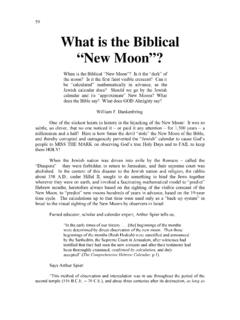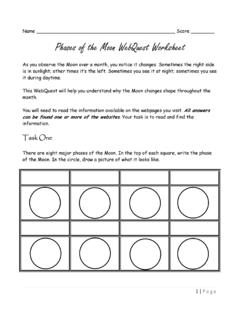Transcription of EARTH, MOON & SUN - Mueller Planetarium
1 earth , moon & SUNC lassroom aCtivitiesPLANETS, Morehead Planetarium and Science Center, University of North Carolina at Chapel Hill, NC 27599 2010, 2011 by Morehead Planetarium and Science Center 1 earth , moon & SUNI ntroduction ..2 Connections to Standards ..3 Lesson Planning ..4 Classroom aCtivitiesStories that Teach Us: Learning about Fables ..5 Coyote and Sun: Learning about Food Chains ..10 Write Away: Learning to Use Experiences to Develop Writing ..12 Looking Up: Learning More about Words Related to Space ..14 BaCkground informationAbout Navajo Story-Telling Traditions ..19 About Coyotes ..21 About the Sun ..23 Key Scientific Vocabulary ..25 CONTENTSPLANETS, Morehead Planetarium and Science Center, University of North Carolina at Chapel Hill, NC 27599 2010, 2011 by Morehead Planetarium and Science Center 2 earth , moon & SUNINTRODUCTIONThe earth , moon & Sun Planetarium show is an immersive learning experience that in-volves students in looking, listening, con-templating, and inquiring.
2 As a teacher, you can build on this experience by continuing with related discussions in your classroom and ex-tending these to reading, writing, and hands-on learning activities. In the following pages are some examples of approaches you can take. Morehead Planetarium and Science Center cre-ated earth , moon & Sun to help children ex-plore the relationship between our home planet and its most familiar neighbors. Children are helped in their exploration by Coyote, a char-acter adapted from Native American oral tradi-tions. Native American stories woven through-out the show illustrate how we have long sought to understand our planet and the skies above this show, Coyote proves to be an amusing guide because he has so many misconceptions about space. Coyote s confusion brings sci-entific facts to light and helps students think about how earth , moon , and Sun work together as a system. Students learn why the Sun rises and sets and the basics of fusion and solar en-ergy.
3 They examine the moon s orbit, craters, phases, and eclipses. The show also describes past and future space travel to our moon and beyond. The earth , moon & Sun show and related class-room activities connect to a range of standards-based science and non-science content, while also responding to children s varied interests and learning styles. Viewers of all ages can ap-preciate earth , moon & Sun, but students in Grades 2-5 will especially enjoy and benefit from this engaging exploration of the earth - moon -Sun system. RPLANETS, Morehead Planetarium and Science Center, University of North Carolina at Chapel Hill, NC 27599 2010, 2011 by Morehead Planetarium and Science Center 3 earth , moon & SUNCONNECTIONS TO STANDARDST here are specific North Carolina Standard Course of Study goals and objectives dis-cussed in earth , moon & Sun.
4 These in-clude the following Grade 3 Science Objec-tives:Objective Observe that objects in the sky have patterns of movement including stars, the sun and the moon . Objective Using shadows, follow and re-cord the apparent movement of the sun in the sky during the day. Objective Observe and record the change in the apparent shape of the moon from day to day over several months and describe the pat-tern of changes. Objective Observe that patterns of stars in the sky stay the same, although they appear to move across the sky nightly. Other concepts including gravity, fusion, eclipses, and exploration are also discussed in the standardsTeachers will notice that science and non-sci-ence content in earth , moon & Sun can be con-nected to a variety of lesson plans for students in Grades 2-5. For instance, the Coyote and Sun activity included in this guide demon-strates how the show may supplement lesson plans addressing Grade 5 Science Objective : Discuss and determine the role of light, temperature, and soil composition in an eco-system s capacity to support addition to the essential standards in the North Carolina Standard Course of Study, our state has recently adopted the new Common Core State Standards.
5 This earth , moon & Sun guide to classroom activities contains materials to help teachers begin to build lesson plans that connect with the themes of these standards. Stories that Teach Us, Write Away, and Looking Up have been developed with the English Language Arts Common Core Stan-dards in mind. RPLANETS, Morehead Planetarium and Science Center, University of North Carolina at Chapel Hill, NC 27599 2010, 2011 by Morehead Planetarium and Science Center 4 earth , moon & SUNLESSON PLANNINGThis guide describes a variety of activi-ties that build on content referred to in the earth , moon & Sun show. Because writing is such an important skill to develop throughout a child s school years, many of the activities emphasize language arts.
6 Science, social studies, and information skills are also addressed. The activities in this guide can be conducted during class periods after students see earth , moon & Sun. Some of the activities can also be used to help to prepare students for the experience of seeing the show. (Training and materials for additional activities includ-ing many connected to earth , moon & Sun s astronomy and math content are included in the Morehead s A Peak at PLANETS teacher workshops.) The following sample lesson plan uses ac-tivities selected from the earth , moon & Sun classroom activities guide: teaCHer s guide: Before tHe sHowPart 1. Review Information for Teachers: About Coyotes (pp. 21-22) and Write from Your Research: Prompt A (p. 13). Let students know that a coyote plays an important part in the Planetarium show they will be seeing. To get ready, they re going to find out about coy-otes.
7 Ask students to (individually or in groups) prepare short factual reports on coyotes. In a class discussion, first explore what students may already know about coyotes. Follow with a web quest or research in books from the school s media center. Students can draw pic-tures to accompany their 2. Review Information for Teachers: About the Sun (pp. 23-24) and Coyote and Sun: Learning about Food Chains (pp. 10-11). Using their research about coyotes, stu-dents can create food chains in which coyotes are links. They can also create paper-bag pup-pets of the Sun, Coyote, and other organisms in their food chains and present simple skits illustrating the transfer of energy within their chosen ecosystems. teaCHer s guide: after tHe sHowPart 1. Lead students through the pre-writing prompts outlined in the first part of Write Away: Learning to Use Experiences to De-velop Writing (pp.)
8 12-13). Assign one of the Write from Your Experience prompts (p. 13) or develop a prompt to help students translate their experience of the earth , moon & Sun show into writing and discussion. Part 2. Review Information for Teachers: About Navajo Story-Telling Traditions (pp. 19-20) and Stories that Teach Us: Learning about Fables (pp. 5-6). Use your students pre-writing about earth , moon & Sun to spark dis-cussion about story-telling traditions, including fables. Discuss Coyote and Crow. Ask your students to write their own fables about Coyote and other animals that can be found together in ecosystems. You may wish to assign some of the words that were listed on the board dur-ing pre-writing. Students can create paper-bag puppets (or use those they created earlier) and team up with other student-authors to act out their fables for the class. RPLANETS, Morehead Planetarium and Science Center, University of North Carolina at Chapel Hill, NC 27599 2010, 2011 by Morehead Planetarium and Science Center 5 earth , moon & SUNThe central character in earth , moon & Sun our guide from misconception to understanding is Coyote, a character adapted from Native American oral traditions.
9 The following pages include an example of a Navajo fable that also features Coyote. This example will provide an opportunity to discuss story-telling traditions and fables as a literary form. In reading the tale, students can explore the flora and fauna of the Southwest (the tale s setting), the motives of the two main charac-ters, the lesson the tale teaches, and why such a lesson might be important to a activities described here can help teachers address several of the new Common Core Stan-dards. For instance, the English Language Arts Reading standards for Grades 2-3 ask students to recount stories, including fables and folk-tales from diverse cultures, and determine their central message, lesson, or moral (Standard 2).teaCHer s guideWoven throughout the earth , moon & Sun show are traditional Native American stories based on observations of the world around us and the sky above us. The stories in the show feature Coyote, who is often the leading character in such tales.
10 Coyote is known as the trickster, because he is sometimes actively mischievous. But sometimes Coyote is simply flawed in the ways humans can be greedy, impatient, un-reliable, overly ambitious. In earth , moon & STORIES THAT TEACH USLEARNING ABOUT FABLESPLANETS, Morehead Planetarium and Science Center, University of North Carolina at Chapel Hill, NC 27599 2010, 2011 by Morehead Planetarium and Science Center 6 earth , moon & SUNSun, for instance, we find Coyote hastily scat-tering the stars instead of placing them care-fully in the sky as he is supposed to. Like any interesting character in a story, Coyote gives readers and listeners much to consider, as they think about his actions and motivations and try to learn from story told in earth , moon & Sun in-volves Coyote, Crow, and moon .








